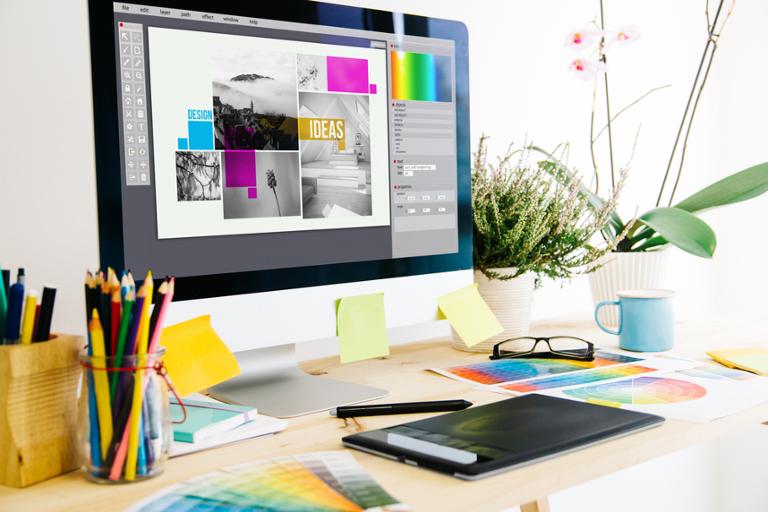A graphic designer’s chief role is to develop, design and produce graphic art for an assortment of print and digital materials that are intended to attract, engage and/or convert customers.
A graphic designer could work on corporate identities, printed marketing collateral, email campaigns, web pages, printed or digital advertisements, signage… the list goes on (and on, and on). In addition, graphic designers who focus on software must design materials that are attractive and readable in a variety of formats, from the largest PC monitors all the way down to the tiniest smartphone screens. Ultimately, to become a graphic designer demands a mix of not only graphic design skills, but also "soft skills" such as really good communication.
“Graphic designers often have to meet tight deadlines, work across mediums and collaborate in teams,” Diane Domeyer, executive director of The Creative Group, said. “And they need to communicate with clients—internal or external—pitching concepts and presenting their final work.”
The fundamentals of graphic design can include design, typography, layout and some illustration, as well as visualization, digesting briefs, preparatory work, research, artworking and file preparation, color management, industry software literacy, and scheduling and deadline monitoring. It’s a role where attention to the smallest detail is absolutely everything; in extreme cases (and particularly in UX/UI), good design can also mean the difference between a useful tool and something very bad happening, even thermonuclear annihilation.
Roz Nazerian, co-founder and creative director of Minx Creative, said that, as a designer grows with experience and moves into more senior roles, their responsibilities will also expand: “That can include more of the day-to-day running of the studio, including project planning and management, quality control, and attending client and partner meetings.”
Graphic Designer Work Environment
As Domeyer also noted, there are generally three work environments for graphic designers. One is an agency, where you’d work on design needs for multiple clients, which she said provides a lot of variety and can be very fast-paced. (Unless you’re someone like Jony Ive, in which case your agency has pretty much one client—and even then, things can become quite speedy, depending on product-launch deadlines.)
The second option is working in-house, where the person is a graphic designer for one company, giving them the opportunity to develop the brand and have greater influence on products and marketing.
Lastly, many graphic designers choose to be freelancers, which often allows greater control over projects and work schedules.
“One work environment isn’t better than the other—agencies, in-house departments and freelancing have their advantages and disadvantages, and it depends on the designer where they want to take their career,” Domeyer said. “It’s less of a career path and more of a career journey, with twists and turns along the way that are specific to the individual and their interests and passions.”
Nazerian suggested that it’s important to be open to learning a selection of skills, honing your craft and finding an environment that best supports your growth. The graphic design field is diverse and always evolving.
An example of a typical graphic designer career path within Minx Creative: junior, mid-weight, senior, creative director; and within that arc, some designers will choose to specialize, be it on branding or identity, print, motion design, Web, applications or digital.
Typical Job Posting
A job posting for a graphic designer should paint a clear picture of the required responsibilities, skills, and experience needed, Domeyer explained.
Hiring managers should think about the variety of projects the new hire will work on and consider what skills and experience would be absolutely necessary for the position. From the job seeker’s perspective, that should translate into clear listings of necessary skills (Adobe Creative Suite, Photoshop, various programming languages, typography, creativity etc.). Many job postings will also highlight a position’s need for “soft skills” such as communicating with teams and effectively delivering presentations to clients and managers.
“When browsing job descriptions, graphic design professionals should look for a role that they find interesting and matches their experience level and career goals,” she said. “If the description lists several responsibilities that you dislike about your current or previous job, it’s probably not the best fit.”
Education/Training/Certification
The most basic skills needed for a graphic designer are an understanding of design theory, concept development and the aforementioned Adobe Creative Suite; in the graphic design field, experience may actually prove more important than education.
“Getting a degree in graphic design is still valuable, but gaining experience and building a portfolio is a great way to show you are qualified for a role,” Domeyer added.
Individuals will need to be able to demonstrate their technical aptitude as well as their design aesthetic, especially in the context of website and app design; as new, cutting-edge technologies such as augmented reality (AR) and virtual reality (VR) come online, graph designers will need to grasp the nuances of design in those spaces, as well.
In addition, a designer needs to be able to communicate how they applied their skills to create and execute a concept to meet a specific objective. “Technology has had a significant impact on the design world. Graphic designers have seen their scope of projects expand and have had to develop digital skills in order to stay marketable,” Domeyer said. “Graphic designers now need to develop content for online consumption—digital advertisements, web pages, email and mobile.”
She noted that, while a strong understanding of the Adobe Creative Suite remains crucial, it’s also important to understand how a website or mobile device works, and what appeals to users when designing for different channels.
Additionally, as products such as Adobe Create Suite increasingly automate and enable the design process, designers’ productivity has increased. For example, graphic designers can spend less time on routine tasks and more time conceptualizing, solving design problems, and strategizing.
At the most fundamental level, graphic designers should master the following applications in the Adobe Creative Suite:
For web development work, knowing a handful of languages (as well as the fundamentals of web frameworks) is insanely useful, including CSS and HTML.
Typical Graphic Designer Job Interview
Applicants should be prepared for a mix of personal and technical graphic designer interview questions for a position. It’s important to be willing to defend your point of view when it comes to design choices.
Domeyer said be prepared to answer questions about where you gain inspiration for your design work—that includes being able to name industry publications or specific sources that you follow.
As she noted, it will be critical to explain how you would handle challenges throughout the design process, providing specific examples from your experience in the past.
Job applicants should also be prepared to field questions about how they take and respond to constructive criticism, as well as questions about how they collaborate with others, especially clients.
Graphic design applicants will also likely be asked to describe what they feel is their most successful project, the role they played in its execution, and any skills that were developed along the way. If you’re applying for a very specific kind of design role—ideating AR apps for iOS and Android, for example—be prepared to show how your previous experience would map as directly as possible onto the new role.
“Describe the role you played in the design life cycle,” Domeyer said. “Be ready to talk about the experience you have in writing creative briefs, researching, creating concepts, and development and production.”
What to Include on a Résumé/Cover Letter
Domeyer said that, in today’s digital environment, it’s important to highlight technical skills such as web and mobile design in a graphic designer résumé or cover letter.
“More and more, graphic designers are asked to create designs for digital media. Those who are versatile will be in demand,” she explained. “Create a portfolio that shows off your best work and a variety of design projects, like digital ads, web pages, signage, branding, email campaigns, and more.”
She explained it’s also important to demonstrate soft skills and knowledge of the industry in your application materials.
“Creativity, adaptability and communication and problem-solving abilities are all essential for graphic designers,” she said. “If possible, also articulate the business impact of your work, like a measurable improvement for the company or specific contribution you made above and beyond your responsibilities.”
Nazerian also pointed out that while skills and industry experience are both important, it’s important to partner that with personal attributes. “An individual with drive, determination and a positive attitude will go a long way,” she said. “Think carefully how you wish to present yourself and always be imaginative with your application—we really like receiving posted applications; they stand out head and shoulders above our emailed ones.”
Last but certainly not least, independent projects can prove insanely valuable when you're trying to show off your skills for a new employer. Make sure that your project portfolio is in order before you start applying for gigs, and ensure that you can talk a future interviewer through your best projects (and the skills you used on those projects).


